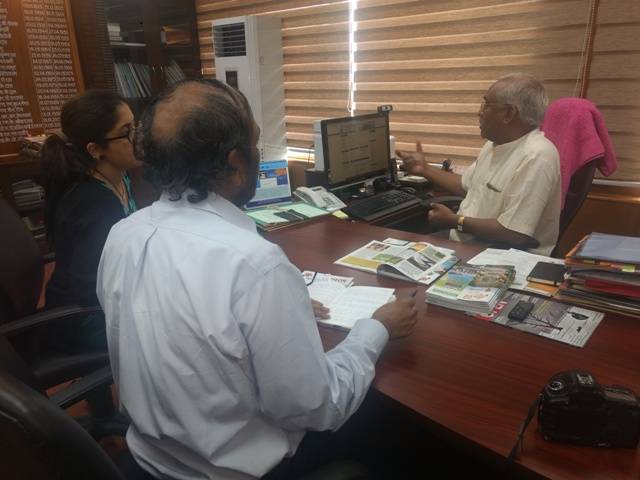
The combination of nowcast warnings, state-level monitoring and satellites. This data allows us a lead time of two to six hours to issue severe weather warnings
Heavy rain is expected to lash large parts of Southern India especially in Telangana as the Indian Meteorological Department (IMD) has issued a 3-day warning for the entire state.
Stating that some areas would receive 'heavy rain' while others would receive 'extremely heavy rain', the IMD issued an alert for the districts of Nalgonda, Suryapet, Khammam, Bhadradri Kothagudem, Jayashankar Bhupalapalle and Mahabubabad.
The IMD said that Warangal Rural and Warangal Urban districts would also witness heavy showers. The alert will be in place till 8:30 am on July 11 and could be extended further.
The rain is a result of a low-pressure area over northwest Bay of Bengal and the associated upper air cyclonic circulation around it.
Dark clouds covered large parts of Hyderabad on Sunday as well as several parts of the city witnessed mild rainfall.
On Saturday, the heads of several departments in the Telangana government held a convergence meeting in Hyderabad.
Krishi Jagran Team visited Indian Meteorological Department (IMD) and met Shri K J Ramesh < Director General, IMD and asked about the IMD`s Predictions of Heavy Rains and Thunderstroms.

Here are Excerpts:
There was IMD`s Prediction about the Thunderstorms. How are these effective in view of the intensity of these rains and storms?
This time, on May 2, along with the usual conditions that favour a thunderstorm, a western disturbance (WD) affected Northwest India. WD is a rain-bearing system and when it joins another rain-bearing phenomenon, they combine and cause widespread activity. As far as dust storms are concerned, there was immense heating across Rajasthan and wherever there was no moisture, dust storms occurred.
Are these predictions are 100 percent correct or some time it may not happen also !
If you see, we had issued warnings from May 30 onward based on specific colour codes. After initially issuing a yellow warning, which meant 'keep watch', we upgraded it to orange which is a warning to be alert and prepared. The subdivision-wise warnings were also upgraded. These are all probabilities of occurrence of severe weather, in the course of 24 hours. That doesn't tell you specifically where the weather activity will occur during the 24-hour period. For that, we have the combination of nowcast warnings, state-level monitoring and satellites. This data allows us a lead time of two to six hours to issue severe weather warnings to all relevant authorities. A thunderstorm activity has a lifecycle of 4-6 hours so that a specific spell of severe weather duration has to be monitored through radar and satellite only.
The Met Department informed that Delhi and its neighbouring states will see a thunderstorm on Tuesday while it actually occurred on Monday night. The specific warnings could have prevented shutting of schools and other such actions !
See, we update warnings as and when there is a change in intensity and when there is a change in conditions. We have to learn how to respond to these situations. We have learnt this for cyclones, heat waves, heavy rains too now. But for thunderstorms, we do not have any response systems as to how institutions, individuals, government departments and others respond. We have been giving thunderstorm warnings for some time, but now attention has been paid to these warnings due to casualties caused by last week's storm. We must build appropriate emergency measures for thunderstorms too.

IMD has more resources and information than private forecasters, but the dissemination of forecasts is happening through limited platforms and the language is still jargon-heavy. What is IMD doing to change this?
We are currently sending alerts to governments through SMS. I don't have means of disseminating information to everybody; multiple agencies and governments will ensure that. That too is happening. As far as language is concerned, we are constantly working to make things easier to grasp.
Has the monsoon surpassed expectations? How has the progression of monsoon been so far?
Till yesterday, monsoon has been very good and as far as the quantum is concerned, almost close to the normal level as expected at this time of the season. The distribution of rainfall is also fairly good. Some areas, particularly interior Karnataka, Kerala and some parts of Tamil Nadu and Jharkhand have received lesser than expected quantums.
Do you see things stabilising in those regions? What is the kind of rainfall that we have witnessed in India so far?
In India, rainfall has been quite good in most of the regions, very close to normal. Barring seven subdivisions out of 36, all have received normal or excess rainfall. That way it is very good and most of the areas will receive rainfall in this week, particularly Jharkhand, Chhattisgarh, Orissa, Madhya Pradesh, east Rajasthan and even northern parts of Maharashtra like Vidarbha, Marathwada and coastal Andhra Pradesh and even Karnataka should get because there is a system forming over the north Bay of Bengal. That should give very good rainfall distribution in the next four, five days to come.
Any unusual patterns that you are seeing this year. Or has it been completely in line with what IMD expected?
There is no aberration, except south interior Karnataka and Kerala which we were hoping to have a better scenario compared to 2016. But so far deficits are much less compared to the previous season. But still there is a deficit.
What about the states especially in UP and West Bengal? Are they seeing deficient rainfall?
Only Gangetic West Bengal and Jharkhand have some deficit. UP and all, eastern UP, west UP, Bihar have got a good quantum of rainfall despite late monsoon advancement.















Share your comments